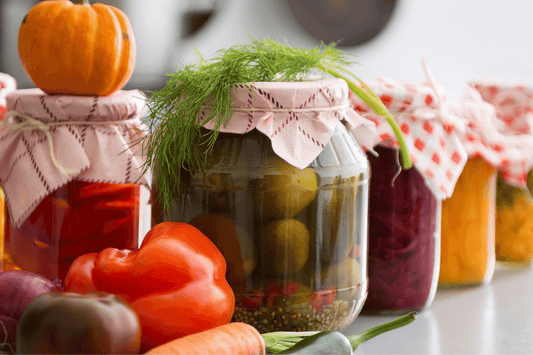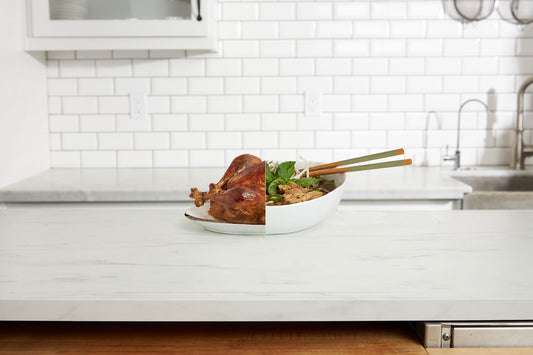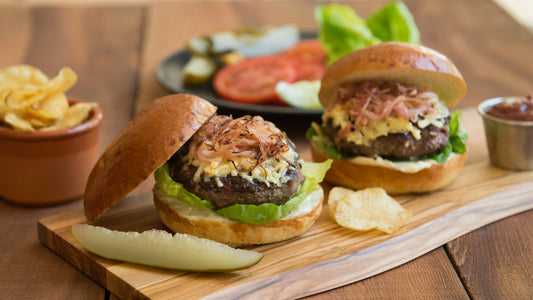Take a look at the cooking oil section at your local supermarket and you’ll see dozens of choices — and we’re not just talking about brands. There’s olive oil, of course, but also vegetable oil, canola oil, safflower, sunflower, grapeseed and sesame seed. Then there are the animal fats, like butter, bacon drippings, chicken schmaltz, duck fat and lard. Clearly there’s a world of cooking oils out there, some more flavorful than others, but it’s not always clear which one to use. Our team of expert chefs and culinary scientists want to make it easy for home cooks to know which oils to reach for, and why. So they created an easy-to-read chart that breaks the oils down into the two main categories that matter most: temperature and flavor.
TEMPERATURE
Oils that remain stable at high temperatures are ideal for high-heat cooking methods like searing, sautéing and frying. The cooking oil chart lists them in order of their smoke point, which means the temperature at which the oils will break down and start smoking. The higher an oil’s smoke point, the higher heat it can withstand. You want to stay below an oil’s smoke point, so that you don’t end up with a smoke-filled kitchen and burnt or “off” flavors in your food. Oils with a high smoke point are typically refined to remove any minerals and flavor compounds that tend to burn at high heat. That’s why they’re very neutral in flavor. Even butter can be refined into clarified butter, or ghee, to improve its smoke point. By removing the milk particles that are susceptible to burning, the remaining fat can withstand much higher temperatures. Of course, clarified butter doesn’t have nearly as much flavor as the original —there’s a reason why we don’t slather our morning toast with it. And that leads us to the second category: flavor.FLAVOR
Just about any oil can be used at the moderate heats we typically use for slower sautés and “sweating” vegetables. So when you’re not cooking with high heat, there’s a whole other set of flavorful oils and animal fats to consider. First, though, you’ll need to decide if you actually do want a neutral-flavored oil, so that it doesn’t interfere with the other flavors in the dish. Otherwise, consider how the flavors of the oils might enhance the finished product. They’re even listed by smoke point on our chart, so you’ll know how far you can push their temperatures. Extra-virgin olive oil, with its grassy, piquant flavors, goes beautifully with Mediterranean dishes. But when making a Thai curry, how about reaching for the coconut oil instead? Try using a dollop of bacon grease to go with those skillet-tossed kernels of corn, or drizzling your potatoes in duck fat before roasting, to make them even more rich and savory. You see, the beauty of these flavorful oils is that they do double-duty, serving as a cooking medium and an agent of flavor.
KNOW YOUR OPTIONS
Avocado oil is rich in healthy monounsaturated fats and mildly buttery, making it great for everything from vinaigrettes to drizzling on popcorn. And its impressively high smoke point means it’s just fantastic for frying too. (Smoke Point: 520ºF / 271ºC)
Safflower oil has a very high smoke point and a completely neutral flavor, which is why it's ideal for deep frying. Most of the oils are made with high oleic seeds, giving this oil a fatty-acid profile similar to olive oil. Studies show oleic acid can reduce the risks of heart disease. (Smoke Point: 500ºF / 260ºC)
Ghee / clarified butter is made by removing the milk solids in butter, resulting in a flavorful fat that’s perfect for high-heat sautéing. Often used in Indian cooking, ghee’s buttery flavor adds richness to all kinds of dishes. (Smoke Point: 485ºF / 252ºC)
Grapeseed oil is a byproduct of winemaking that’s rich in vitamin E. One tablespoon provides 19 percent of the recommended daily allowance. Its clean flavor and high smoke point make it incredibly versatile. (Smoke Point: 480ºF / 249ºC)
Corn oil is a neutral, all-purpose, high-smoke-point oil interchangeable with vegetable, peanut and sunflower oils. Its faint roasty, buttery notes make it ideal for dishes like fried chicken and French fries. (Smoke Point: 450ºF / 232ºC)
Vegetable oil can be made with a mix of different oils, including soybean, safflower, sunflower and corn. It has the same neutral flavor and high smoke point of those oils, but, because it’s a blend, it's a less expensive alternative. (Smoke Point: 450ºF / 232ºC)
Peanut oil is light and nutty in flavor, and because it doesn’t absorb other flavors, it's ideal for frying a variety of foods. Keep in mind, though, that foods cooked in peanut oil can be a problem for those with peanut allergies. (Smoke Point: 450ºF / 232ºC)
Sunflower oil is another all-purpose option that’s high in heart-healthy polyunsaturated fats, especially oleic acid, and vitamin E. It’s not as widely available as some of the other all-purpose oils. (Smoke Point: 450ºF / 232ºC)
Palm oil is a saturated fat commonly used in packaged foods because it enhances crispness, texture and shelf life. It’s semi-solid at room temperature, like other saturated fats (think lard) and partially hydrogenated oils (think shortening). Be sure to look for sustainably produced palm oil. (Smoke Point: 450ºF / 232ºC)
Sesame oil oil is available in two different forms — light sesame oil and toasted sesame oil. Light sesame oil adds nutty flavor to sautés, though it’s not always easy to find. Toasted sesame oil, however, can be found on the international aisle of most supermarkets. It doesn’t take well to heat, but it works great as a finishing oil or in salad dressings to add a boost of sesame flavor. (Smoke Point: 410ºF / 210ºC)
Tallow, aka beef fat, is a saturated fat, and a little goes a long way. It has a meaty flavor that enriches savory dishes, while its medium-high smoke point adds versatility. Yorkshire pudding (essentially a big popover) is the most classic use for beef fat, but since it’s semi-solid at room temperature you can use it in savory pastries too. (Smoke Point: 400ºF / 205ºC)
Canola oil is made from a special breed of rapeseed. This neutral oil with a high smoke point is a versatile and inexpensive choice that you can use pretty much anywhere. It’s high in healthy fats too. Choose expeller-pressed oils, as they aren’t produced with solvents. (Smoke Point: 400ºF / 205ºC)
Schmaltz (chicken fat) is traditionally made by adding onions to the process of rendering the fat from chicken. This adds even more savory flavor. But even plain chicken fat from pan drippings is delicious. (Smoke Point: 375ºF / 190ºC)
Duck fat is even more rich and savory than chicken fat, and can enhance anything with luscious depth, especially vegetables. Commonly used in French cooking, you can often find tubs of duck fat in the freezer section at well-stocked supermarkets. (Smoke Point: 375ºF / 190ºC)
Lard (pork fat) has a clean, yet porky flavor that can boost a wide variety of dishes. The best quality lard is leaf lard, which comes from around the kidney area. It’s exceptional for frying, and is even used in pastry, because it creates crispy results. Choose high-quality unprocessed lard (i.e. not hydrogenated, which produces transfats) from butcher shops. (Smoke Point: 370ºF / 188ºC)
Coconut oil, especially virgin coconut oil, is especially rich in coconutty flavor, making it a flavorful vegan alternative to animal fats. Like animal fats and palm oil, it’s a saturated fat that’s semi-solid at room temperature, which means it can be used for baking too. (Smoke Point: 350ºF / 177ºC)
Butter adds sweet dairy richness to a wide variety of sautéed foods, from fish to vegetables. There are few things that don’t benefit from being sautéed in butter, especially because its milk solids add an extra layer of flavor. In fact, if you cook butter until melted and the milk solids turn lightly brown, you’ve created a luscious ingredient called brown butter (or beurre noisette in French). Its nutty caramelly notes work with savory and sweet dishes alike. (Smoke Point: 350ºF / 177ºC)
Olive oil, particularly extra-virgin olive oil, is high in monounsaturated fats and antioxidants. It has a robust flavor ideal for sautéing, drizzling and using in dressings. Depending on the variety of olives used, the flavor can range from grassy to buttery. Olive oils labeled “virgin” or “light” are more refined and have a lighter flavor and higher smoke point. (Smoke Point: 330ºF / 166ºC)
OVERVIEW
From now on, when you’re following a recipe on the Cue, you’ll know exactly why our chefs chose, say, canola oil instead of olive oil for that particular dish. And next time you’re cooking freestyle in Control Mode, you can check the chart to select the perfect oil for whatever you want to cook. Picking the right oil for the right dish has never been easier. It’s just one more way we’re taking the guesswork out of cooking.





